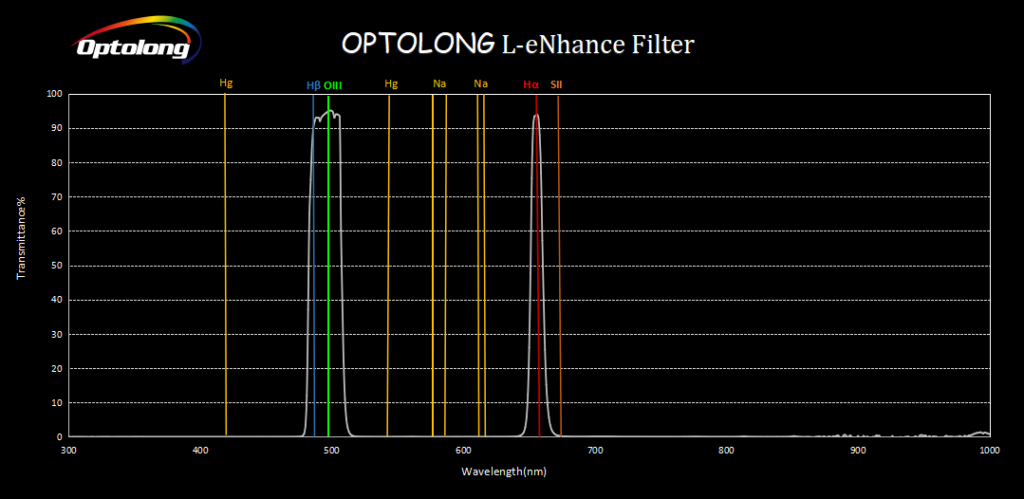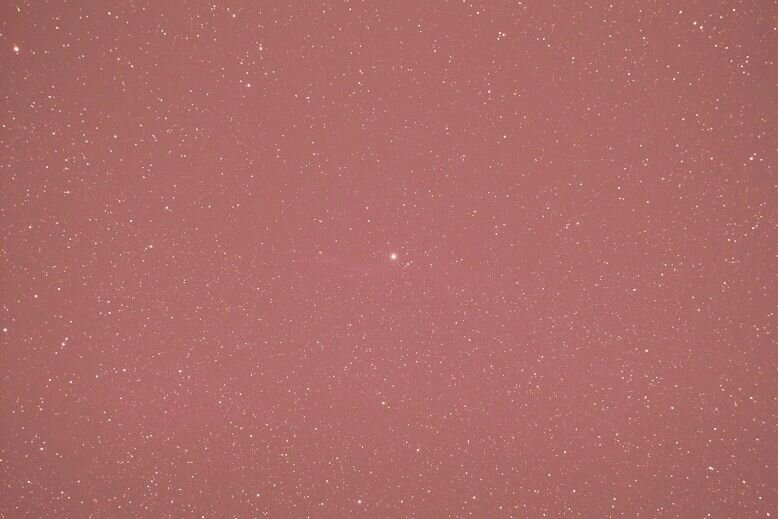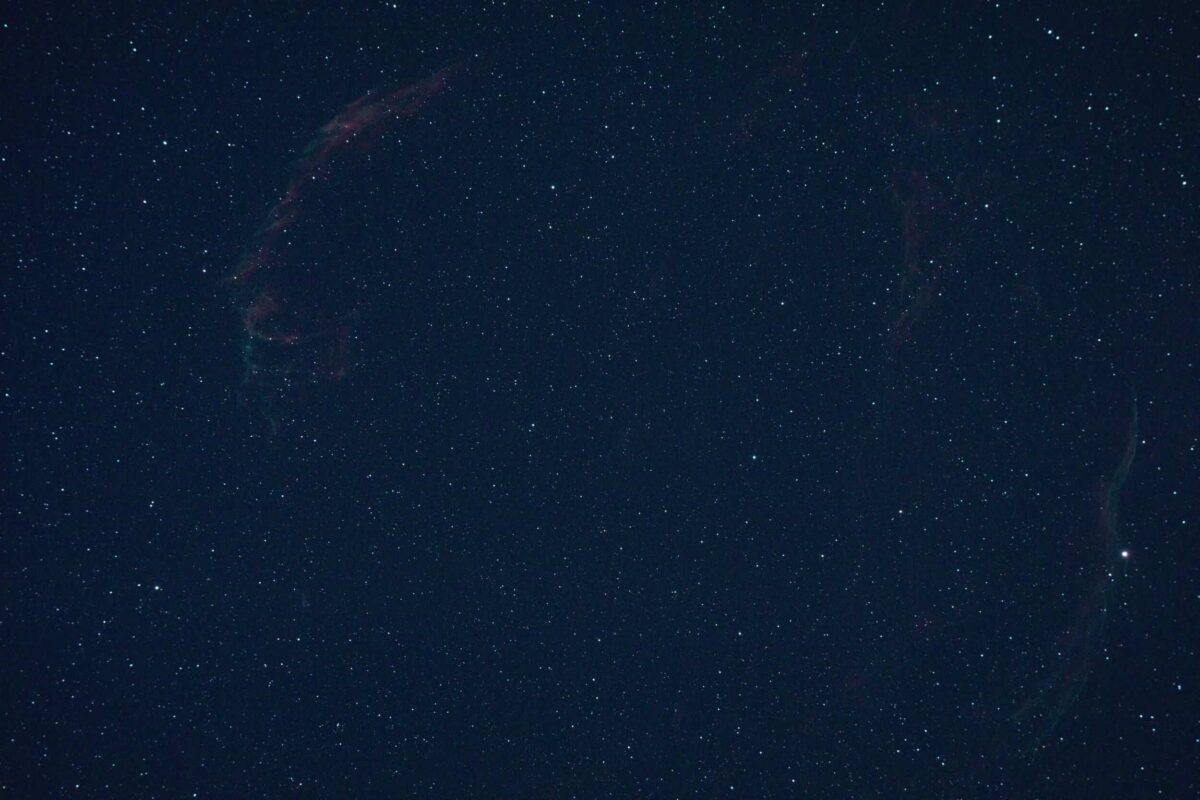With so many different light pollution filters available it’s difficult to know which one to get. The Optolong L-eNhance narrowband filter has been a complete game changer for my astrophotography. If you’re using a one shot colour camera (CMOS, CCD or DSLR), then you need to be seriously considering adding this filter to your arsenal.
The Optolong L-eNhance is a tri-band pass filter, allowing Hydrogen alpha (Ha), Hydrogen beta (Hb) and Oxygen III (OIII) wavelengths through. Isolating these 3 specific wavelengths is key when imaging nebulae such as the Heart nebula (IC1805), and your camera will filter out all that nasty light pollution that can be so damaging for us backyard astrophotographers.
It’s important to note that the Optolong L-eNhance will not work on broadband targets, such as galaxies, as it will block out the wavelengths with the data in for those targets. A popular choice of light pollution filter for broadband targets is the Optolong L-Pro, which you can buy from FirstLightOptics here.

As you can see from the above transmission graph, the narrow band passes that the L-eNhance has, means that you’re really isolating just the wavelengths of data that you want from emission nebulae. In the post I will share some of my RAW subs as a comparison, as that’s where you will really see the power of this filter.
Because of the reasonably wide band pass for Hb and OIII, the L-eNhance can suffer from moon glow, particularly if you’re imaging a deep sky object in the same region of sky as the full moon. That is because the moon gives off a broad spectrum of light, rather than a particular wavelength, and so it would be impossible to completely filter it out, without seriously impacting on the wavelengths we do want, particularly towards the blue and green part of the visible light spectrum.
The newer L-eXtreme filter improves this by removing Hb completely and allowing a much narrower band of light through at OIII, hence the higher price point. In reality, I have found I can get round this in post-processing by applying gradient removal to my images.
Specifications
The specifications below are direct from Optolong. Don’t worry if you don’t know what some of them mean, neither do I! But the results below speak for themselves.
- Substrate: B270
- Thickness: 1.85mm
- Tpeak: T>90%
- Blocking range: 300-1000nm
- Blocking depth: light pollution line blocking >99%
- Surface quality: 60/40
- Transmitted Wavefront RMS: λ/4
- Parallelism (arcsec): 30s
Imaging with the Optolong L-eNhance filter
Since having this filter, I have been lucky enough to create my best ever images of emission nebulae. I have imaged the North America nebula, Elephant’s Trunk nebula, Heart nebula and Soul nebula. All of these images can be found in my gallery here, but are also shown below.

These images would not have been possible without the L-eNhance, certainly not without at least twice the amount of integration time anyway. If like me, you struggle with very few clear nights, then this filter can really help out. It really feels like cheating!
All of these images shown have less than 6 hours total integration time, with the North America nebula only having 3 hours in total! Without the L-eNhance, I would be stretching the image more aggressively to achieve the same level of detail, and in doing so, would amplify the noise in the images. The L-eNhance gives me much smoother, cleaner images which are a dream to process!
If you want to try your hand at processing data but don’t yet have the imaging equipment available, why not support me on Patreon and give it a go yourself!
In this video I share my RAW subs with you, demonstrate curve stretches with and without the L-eNhance and give my unbiased review of the filter.
I have been using the clip-in crop sensor DSLR version of the L-eNhance due to my current setup not being compatible with the 2″ thread, which you would use with a dedicated astronomy camera, such as the ZWO ASI294MC Pro.
The great thing about the clip in DSLR version, is that it’s compatible with all APS-C lenses, so you don’t even need a telescope to gain the benefit of a narrowband filter. In this video, I used the Sky-Watcher Evostar 72ED DS-Pro to produce my images. The 72ED is a compact refractor telescope, and I give a detailed review of the product here.
Image Comparison
Without the Optolong L-eNhance filter


With the Optolong L-eNhance filter

As you can see from the above examples, my subs before the L-eNhance were noisy and over exposed, which was washing out the DSO that I was trying to image. This made post-processing in Photoshop a real challenge, and my final images always had a lot more noise than I would like.
I would suffer with a lot of gradient issues that were really hard to fully cure, even using tools such as the Gradient X-Terminator, it wouldn’t completely solve the issue.
With the Optolong L-eNhance filter, I now start my post-processing with a much cleaner image, meaning I am able to produce much better quality images without over stretching the data and causing gradient issues. If your images suffer with gradient, then checkout my post and video here on how to fix it.
Final Thoughts
The Optolong L-eNhance has revolutionised my astrophotography and taken it to the next level. If your astrophotography suffers from light pollution, then it’s worth looking at the Optolong L-eNhance or the newer L-eXtreme.
Astrophotography filters don’t come cheap, but for good reason. These filters will isolate the wavelengths we’re interested in and filter out all the light pollution, leaving us with a crisp, clean image.
Adding the L-eNhance to your arsenal will mean you’re achieving better quality images, with less integration time – a win all round if, like me, you suffer with few clear nights! You can buy your L-eNhance from FirstLightOptics here – you won’t regret it!

